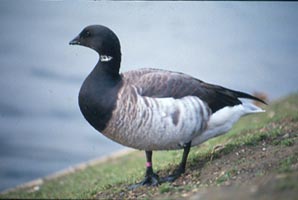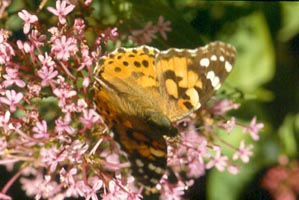COAST
DWELLERS
In
the last few days of May, after the torrential rain had been replaced
by bitter northerly winds it was nice to have some benefit from the
unseasonable weather and be able to see Gannets circling and diving
into the sea a few hundred yards out from White Rock beach. I mentioned
before this side of the hill is often sheltered from the cold winds
and the much calmer waters in Killiney Bay probably made it a lot easier
to see the fish under the surface. The Gannet’s large size and
brilliant white plumage with distinctive black wing tips makes them
easily identifiable from a distance. Gannets only began to breed on
Ireland’s Eye in 1989, and have built up a very successful colony
of over 250 pairs there, and this is probably where these birds were
from.
More commonly seen from the beach or Vico Road is another seabird which
glides out from the cliffs on stiff wings. This is the Fulmar, not a
seagull but a member, like the Albatross (Fulmars are sometimes called
the‘Northern Albatrosses), of the Petrel family. The name Petrel
derives from St. Peter and refers to the birds of this family which
skim low over the water giving the effect they are walking on the water’s
surface. In recent years a number of bird species have moved their breeding
range north in response to milder winters and warmer summers (do not
know what they would make of the ‘springs’ though). Fulmars
expanded their breeding range too but in the opposite direction, moving
down from the north. Before the early twentieth century Fulmars bred
in the far north specifically Greenland and Iceland. In the early years
of the last century they began to be seen breeding in the northern islands
of Scotland and gradually began to appear on cliffs all around the British
Isles and the first breeding birds in Ireland were recorded in Mayo
in 1911. One theory for their expansion is that they followed whaling
ships south feeding on the discarded offal. They also feed on plankton,
fish and squid. When seen flying they are usually seen gliding on stiff
wings barely flapping them at all a manoeuvre that enables them to travel
vast distances using minimal energy. A closer look at these birds reveals
a very unusual, but very handsome, head. Black eyes surrounded by what
looks like mascara but is in fact dark plumage designed to cut down
on glare when the bird is searching on glistening sea surfaces for food.
The bird has a very unusual bill as well, with what looks like a small
tube on top of it. This is used to expel salt that the bird ingests
through seawater when it feeds off the water’s surface. Fulmars
often don’t begin to breed until they are eight to ten years old
and they only have a single chick every year. Small birds like Blue
Tits rarely live more then a few years and have up to twelve chicks
every year whereas long lived birds can concentrate on bringing up a
single chick every year over a long period. Fulmars can certainly be
long lived, with birds that have been ringed in the 1950’s, when
they were breeding adults at least six years old, still alive now and
still nesting and raising chicks well into their 50’s. Sadly our
Dalkey birds sometimes nest where they are vulnerable to human disturbance
and on a number of occasions I have seen people throwing rocks at them
from the railway line and the cliff tops, an act of gross mindlessness
trying to injure these lovely creatures.
Fulmars do have a unique way of defending themselves when they are sitting
on their nest which is to expel the contents of their stomach, a foul
smelling oil on to the approaching predator, basically projectile vomiting
on whatever approaches. When done to other birds it can actually destroy
the oils on their plumage that keeps them waterproof. This habit explains
the origin of their name Fulmar an Icelandic word meaning ‘foul
gull’.
|



